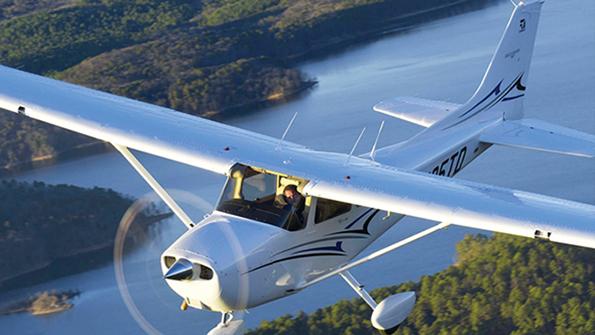
The Collier Trophy goes to “the greatest achievement in aeronautics or astronautics in America” during the preceding year. One year it went to Chance-Vought’s F8U Crusader, a just-launched U.S. Navy fighter. Fine choice, but the right one?
After all, there was another aircraft that also first flew in 1955, Cessna’s Model 172 Skyhawk, a Mach 0.17 (125 mph) performer versus Crusader’s Mach 1.2. And yet that and its other modest numbers, including a base price of $8,750, made Cessna’s new low-tech model an instant hit. Why?
An iteration of the four-seat, high-wing Model 170, the 172’s principal difference was its landing gear. The 170 was fitted with two main fixed gear forward and a tailwheel, a so-called “conventional” configuration, whereas the 172 substituted a nosewheel for the tailwheel—a “tricycle gear” setup. To the unfamiliar, that may seem inconsequential, but most pilots prefer the latter by far.
A tailwheel plane’s nose points skyward while on the ground, and the angle can be so pronounced as to block the view of the pavement ahead. Consequently, the pilot must sashay while taxiing. And when landing, the runway can disappear again just before touchdown, making rollout an act of faith. Additionally, crosswinds require serious rudder and aileron work when taking off, touching down and on the ground since the forward placement of the main gear results in an aft center of gravity (CG), which, combined with a castoring tailwheel, can cause the aircraft to “weather-vane” into the wind.
By contrast, tri-gear aircraft sit level, providing a clear view forward when on the ground. And most nosewheels do not swivel, which, along with a forward CG, helps stabilize the aircraft from crosswind forces while on the ground.
The seemingly simple switch resonated with buyers, and Cessna delivered a remarkable 1,400 172s in 1956, the first full year of production. Thanks to that nosewheel and the aircraft’s stellar operating record, they have been buying ever since.
Martha King, a co-founder with her husband, John, of the well-known King Schools pilot instruction company, recently described the 172 thusly: “It’s dependable, predictable, well-mannered and maintainable by almost anybody.” To which John added: “And trustworthy, reliable and capable.”
In addition to their Dassault Falcon 10, the Kings have owned several 172s, purchasing their current one last year. Long a staple among flight schools globally, the Skyhawk, according to the Kings, is “part of the foundation of civil aviation.” Indeed, it seems most pilots, including many military aviators, have logged time in a 172.
And Mark Baker, president and CEO of the Aircraft Owners and Pilots Association, opines that the 172 is “about the most versatile and forgiving airplane out there, and a great choice for those both learning to fly and looking for their first airplane.” Baker has owned four of the type in his life, including one for his son’s and nephew’s flight training.
Cessna has updated the model regularly with more powerful engines and improved avionics—the current 172S features a 180-hp Lycoming engine and a Garmin G1000 cockpit—but save for the swept fin and rear windows added in the 1960s, its configuration is close to the original. Operators seem to approve.
The 172 Skyhawk has been in manufacture, with a notable interruption, since the outset. Cessna reportedly turned out more than 4,000 during the model’s first five years, but between 1986 and 1996 it suspended all lightplane production while the industry campaigned, ultimately successfully, to resolve product liability issues. Since then, annual Skyhawk output has ranged from 490 in 2000 down to 85 in 2010. Last year it delivered 126 and another 48 in the first quarter of 2020.
In total, more than 45,000 Skyhawks have been delivered, making it by far the most populous airplane ever produced, with more being added every month.
And while the retail price of a new 172 is now $400,000, the Aircraft Bluebook notes that prices for 10- and 20-year-old models average $280,000 and $135,000, respectively—reasonable in a market where the age of a single-engine piston aircraft averages 46 years. As for an original 1955 Skyhawk: yours for $25,000.
All in all, these are impressive numbers for a Medicare-qualified flying machine, one that continues in both widespread service and production. It seems award-worthy to me. Meanwhile, of the 1,261 Crusaders built, the Navy retired its last 33 years ago.






Comments
Real tail dragger pilots NEVER "sashay", we "serpentine" while taxiing.